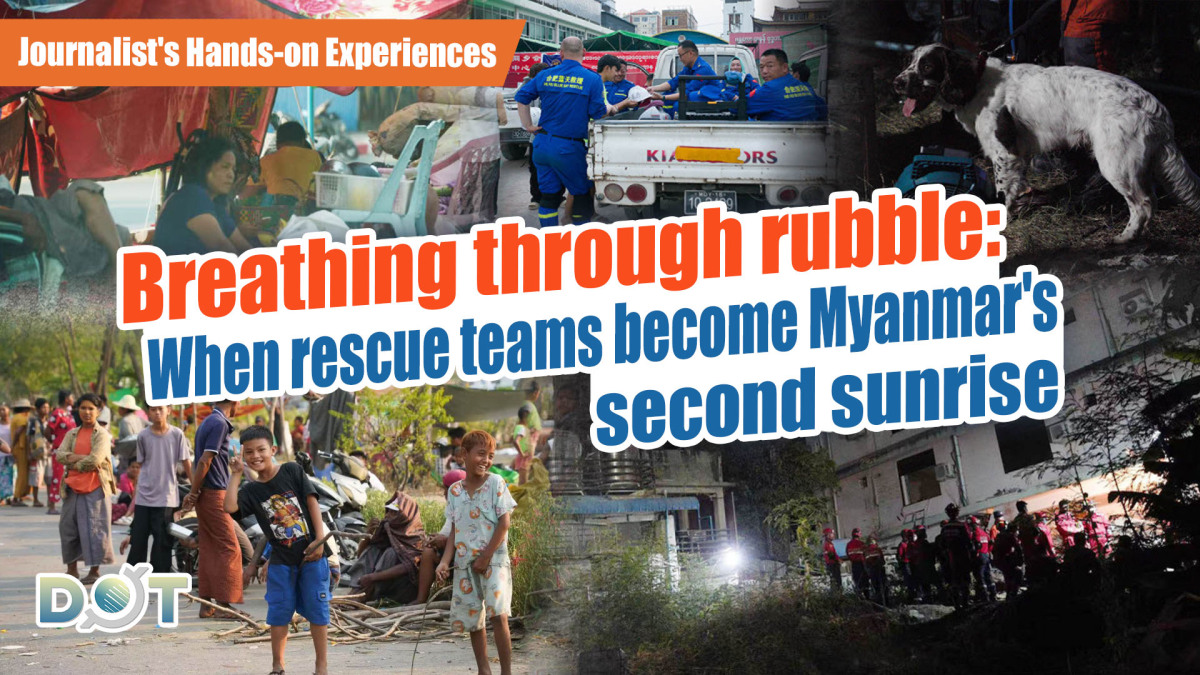
By the time I wrote this journal, it had been 24 hours since we arrived in Mandalay, Myanmar.
Within this brief span, we encountered seven Chinese rescue teams, and also witnessed two rescue operations where signs of life were detected.
In order to keep our editorial team up-to-date with the latest news from the front, we sent nearly a hundred photos and dozens of video clips back to our editorial team in a short period of time.
The past 24 hours have become one of the most unforgettable experiences of my career as a journalist.
We felt the duality of Mandalay's day and night, its blood and tears, the unwavering determination of the rescue teams, and the heartfelt gratitude of the Burmese people.
Rewind to yesterday, April 2. After a grueling 13-hour drive, we finally arrived in Mandalay at 6 p.m. local time. As a photojournalist, I documented the devastation caused by the earthquake along the way: cracks in the roads, collapsed temples, and displaced residents. The closer we got to Mandalay, the heavier my heart grew.
Would the destruction here be as catastrophic as reported?

Upon entering Mandalay, we discovered that while the city was not entirely razed to the ground, most buildings had sustained varying degrees of damage. The most severely affected structures were unrecognizable as former buildings.

Our first stop was the Yangon Yunnanese Association, the designated disaster relief center, where we hoped to gather information from locals. However, before we could settle in, our colleagues informed us that a survivor had been found at the Golden Country Hotel, an 8-minute drive away.
We rushed to the scene immediately.

By the time we arrived, the survivor had already been successfully rescued. From the perspective of a photojournalist, it's somewhat regrettable not to have captured the rescue process, especially the moment when the one trapped under the rubble was brought out. However, the successful rescue of the survivor is undoubtedly uplifting news, giving everyone present a glimpse of hope in the rescue efforts.
We were pleasantly surprised to find that the Hong Kong Special Administrative Region (HKSAR) rescue team was also on-site, having cooperated with the national rescue team to save the survivor.
After a brief exchange, both teams resumed their search efforts.
Exhausted from a day of travel, we decided to return to the Yangon Yunnanese Association for a quick meal and rest. But just as we arrived, the HKSAR rescue team informed us of another potential survivor at the same location.

Driven by our journalistic instincts, we rushed back to the scene again.
By then, four Chinese rescue teams were already working tirelessly, and a fifth team soon joined them. My colleague and I captured every moment—the courage, exhaustion, persistence, and sweat of the rescuers—amid the chaotic and poignant atmosphere.
We sent photo after photo back to our editorial team, who published the selected shots.


It was a sleepless night—for us, the rescue teams, and our editorial team.
After nearly ten hours of searching, with rescuers rotating shifts to combat fatigue, the operation concluded around 3:30 a.m. on April 3. Unfortunately, no additional survivors were found.

We dragged our weary bodies to a temporary resting place.
With most hotels in Mandalay damaged, we had planned to sleep in the car. Thankfully, local colleagues directed us to a relatively safe KTV lounge, where we finally found a place to lie down.
After less than five hours of sleep, we returned to the Yangon Yunnanese Association to gather more information. Following interviews with relief center volunteers, we received news that the Blue Sky Rescue Team from China had detected possible signs of life at the collapsed Great Wall Hotel.
Without hesitation, we rushed to the scene.
The Blue Sky Rescue Team had been working tirelessly through the night. By the time we arrived, they were systematically searching the ruins in pairs, leaving no stone unturned.
The midday heat in Mandalay was overwhelming, soaring above 40°C —a stark contrast to what we're accustomed to in Hong Kong. Everyone was drenched in sweat, including us.

We waited for hours, hoping for a miracle. By 5 p.m., the rescue teams began to withdraw from the site. It became clear that the moment I longed to capture might not come anytime soon.
Through my lens, I saw Chinese rescue teams persevering, tirelessly navigating the ruins of Mandalay. I saw the Burmese people gradually emerging from their sorrow, ready to rebuild their homes. I witnessed their overwhelming gratitude as they repeatedly thanked the Chinese rescue teams, who, like Myanmar's second sunrise, lit up the path of hope before them.
Perhaps Mandalay, as seen through what I captured, will emerge from the shadows of night into the warmth of day, leaving the darkness behind to welcome the light.



(Reported by Alan Mak; English Editor: Zoey Sun)
Related News:




















Comment